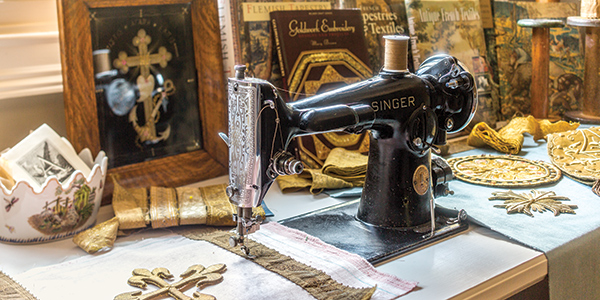
Text by Elizabeth Czapski
Our latest French Cottage special issue hit newsstands last week, and if you’ve picked up a copy, you’re sure to have noticed the incredible handiwork of E Alexander Designs featured within its pages. Since 2004, founder Emily Alexander, who is now based in Oxford, Mississippi, has been designing and creating distinctive antique pillows made from 17th-, 18th-, and 19th-century European textiles and tapestries—discarded fragments and found treasures she’s uncovered by scouring auctions, flea markets, and antiques shows along the streets of France, England, Italy, and beyond. We chatted with Emily to learn more about her background, inspiration, and, of course, her beautiful one-of-a-kind pillows.

The Cottage Journal: Tell us about your background and the journey to getting to where you are today with your business.
Emily Alexander: My mother, Norma, taught me to sew and to do all of the crewel stitches at an early age to keep me occupied. I have always had a love of creating. I obtained a degree in textiles and communications from Louisiana State University, where many of the textbooks were about history of clothing design. Instead of using my degree out of college, I went to work for Delta Airlines in order to travel the world. This enabled me to visit all of the brocante markets in foreign cities. Two of my favorites are Portobello Road in London and the Arezzo Antiques Fair in Italy, which dates back to the 9th century. I loved hearing the stories from the vendors about nuns in ancient times hand-embroidering vestments for the priests. A love of history, textiles, and travel led me to where I am today in my business.

I have been in this business for 20 years. [In the early 2000s] when we lived in California, I visited a textile antiques market at the Santa Monica airport. I met an older lady there who was selling old French embroidery. She was also taking the embroidery off the torn background and attaching it to newer, more stable fabric. The idea of saving these beautiful embroideries was fascinating to me. She talked me through the process. I went home and immediately wanted to create. Most of these old embroideries would have been thrown away because they were so worn and stained. This was going green and recycling at its best.
For years, I went to France, Belgium, Italy, and England to look for Aubusson tapestries and vestment embroideries. The first piece I bought [around 2002] was a needlepoint chair bottom with the letter “A” from a shop owner in L’Isle-sur-la-Sorgue [in France]. The old chair was too big for me to take back on the train, so I took the needlework off the chair and gave the chair to a store owner to resell. I took my first creations to an antiques business called Lyman Drake in Santa Ana, California. The owner of this French antiques store loved the pillows. Thus, the business was born in 2003.

TCJ: Tell us about your creative process—from sourcing European textiles to crafting your designs and producing the pillows.
EA: The embroideries dictate the size and design of the pillow. Sometimes, I wake up at 2 in the morning wanting to create a new design. I do all of the work myself.

TCJ: Tell us about your product offerings. Do you have any best-sellers or are you constantly coming up with different designs based on the one-of-a-kind nature of your sources?
EA: All of the pillows are different because there were so many motifs used by the craftsman embroiderers. One of my favorite motifs is the pelican feeding her young. Customers love the history behind a motif. Many of the designs are one of a kind, but I do custom orders all the time. I always emphasize that they will always be slightly different.

TCJ: What inspires and influences your work?
EA: I love watching historical shows and documentaries on PBS and other channels. I particularly love the costume design of past eras. Fabrics were so luscious. I have recently started incorporating silk brocade and silk moire from the original vestments into my pillow designs.

TCJ: What do you hope people take away from your work? What do you hope your pieces bring to someone’s home?
EA: Many think that it is a very tedious process to cut away all of the deteriorating fabric from an embroidery, but for me, it is a labor of love. I hope the person who buys a pillow from me feels the same joy I felt producing it.
Shop our latest issues for more inspiration!


